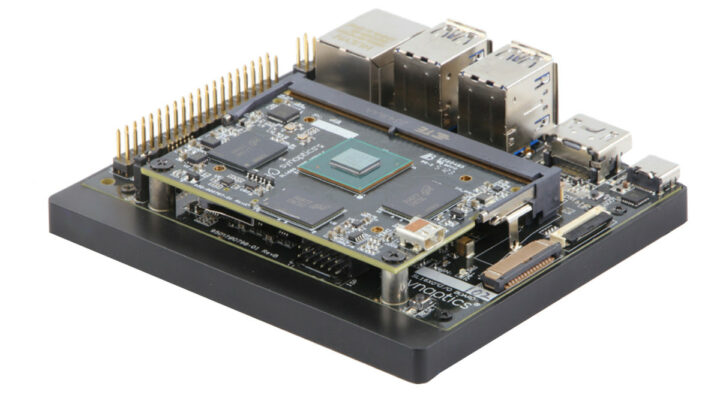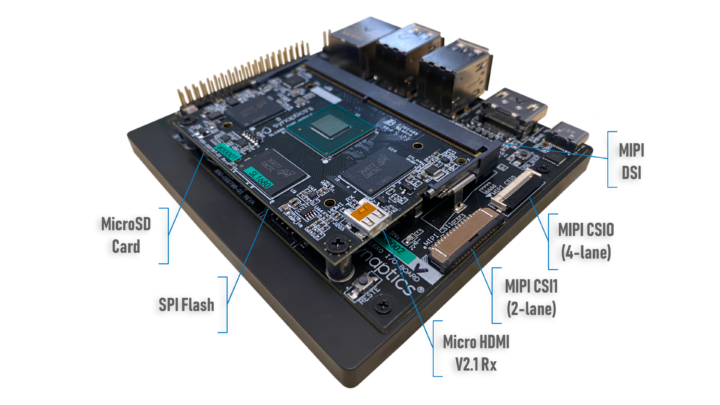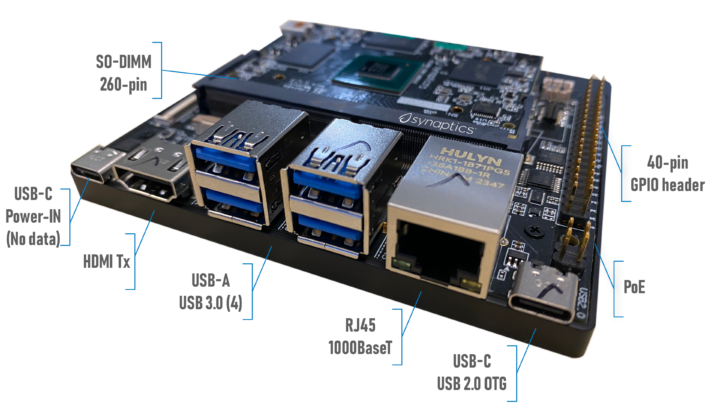Synaptics has unveiled its new Astra platform with a range of SoC and a development kit for edge AI applications. These new processors and a supporting development kit are built to provide out-of-the-box AI capabilities for IoT devices, reducing reliance on cloud-based AI.
This new Synaptics Astra Platform is built around three main SoCs. The SL1680 is built for multi-modal IoT applications and features a quad-core Arm Cortex-A73 CPU, dedicated 7.9 TOPS NPU, and 4K video. The SL1640 is a cost and power-optimized SoC with a quad-core Cortex-A55 CPU and 1.6+ TOPS NPU. Finally, the SL1620 is a graphics and AI accelerator with a quad-core Cortex-A55 CPU and dual-core Imagination BXE-2-32 GPU but does not feature an NPU.
The development kit features a module design where the new swappable compute modules allow flexible configurations. The devkit will support open Yocto Linux distribution and Synaptics AI toolkit for quick AI integration.
Synaptics Astra Platform SL1680 Specifications:
- CPU
- Quad-Core Arm Cortex-A73 processor clocked at 2.1 GHz delivering up to 40000 DMIPS
- 64KB I-cache and 32KB DCache
- Dedicated Arm NEON technology/VFPU for each processor with 32 128-bit SIMD registers and crypto instructions
- 1 MB shared L2 Cache
- Arm TrustZone technology
- Memory/Storage Interfaces
- Up to 4GB 64-bit LPDDR4/LPDDR4x-3733 and optional 32-bit DDR configuration
- eMMC 5.1 Controller with x1, x4, or x8-bit interface
- Neural Processing Unit
- Dedicated hardware for localized NN/machine learning applications
- Up to 7.9+ TOPS
- Supports multiple DNN frameworks and is optimized for TensorFlow Lite inferencing via the SyNAP toolkit
- Multi-Standard Video Decoding
- Support for various video decoding formats including AV1, H.265, VP9, H.264, MPEG-2, and VP8
- Flexible support for PIP and Multi-View configurations
- Single-stream 2160p H.265/VP9 decode up to 90-100 fps
- Support for up to 1080p120 single-stream decode
- Multi-Standard Video Encoding/Transcoding
- Support for up to two streams encoding at 1080p60 with H.264 or VP8 per stream
- Simultaneous 2160p60 decode and 1080p60 transcode
- Audio Decoding/Processing
- Far-Field Voice (FFV) & Keyword Detection
- Microphone(s) input processing supported
- Audio decompression of various formats supported
- Audio post-processing
- 2D & 3D Graphics
- GPU-based graphics engine (Imagination PowerVR Series9XE GE9920)
- HDR-enabled with support for various graphics standards including OpenGL ES, DirectFB, OpenCL, and Vulkan
- Up to 3840×2160 resolution with 3D capabilities
- Video/Graphics Display Pipeline with QDEO
- Two independent display output paths with support for HDR and gamma correction
- Various image enhancement features including scaling, detail enhancement, and color remapping
- Security
- 250MHz Secure CPU (Arm Cortex-M3)
- Secure boot with RSA digital signature verification
- True random number generator
- DRM engine with support for AES, DES, 3DES, RSA, ECC
- Memory and I/O space access control
- DRAM scrambling support
- Audio/Video Inputs & Outputs
- Various input/output interfaces including MIPI CSI 2, HDMI, I2S, S/PDIF
- Support for multiple camera inputs and HDMI input with HDR support
- Standby Mode System Manager – Arm Cortex-M3 for managing standby mode with support for wake-up events such as Voice, LAN, CEC, and GPIO triggers
- Peripherals
- PCIe 2.0 root complex
- Gigabit Ethernet MAC
- USB 3.0 host interface, USB 2.0 OTG interface
- SDIO host interface
- UART interfaces, SPI interfaces, GPIOs, PWM, ADC, and IR receiver input
- Package – 17 x 17mm FCBGA with 0.4mm ball pitch
Note! The specifications below are for the SL1680 SoC, the top-of-the-line processor in Synaptics’ SL-Series. While many features are shared across the series, key differences exist between the SL1680, SL1640, and SL1620. To highlight these differences, I’ve included a comparison table below.
| Features | SL1620 | SL1640 | SL1680 |
|---|---|---|---|
| CPU | Quad-core Arm Cortex-A55 @ up to 1.9GHz Each with 32KB I-cache / 32KB D-cache and 512KB shared L3 cache | Quad-Core Arm Cortex-A55 @ up to 2.1GHz Each with 64KB I-cache / 32KB D-cache and 1MB shared L2 Cache | Quad-Core Arm Cortex-A73 @ up to 2.1GHz Each with 64KB I-cache / 32KB D-cache |
| Memory Interface | 32-bit DDR3/DDR4 up to 4GB with NAND/eMMC controller | 32-bit DDR4-3200/LPDDR4x-3733 up to 4GB with eMMC 5.1 controller | 64-bit LPDDR4x-3733 up to 4GB with eMMC 5.1 controller |
| Neural Processing Unit | - | Up to 1.6+ TOPS NPU | Up to 7.9+ TOPS NPU |
| Multi-Standard Video Decoding | - | Video decoding support with AV1, H.265, VP9, H.264, etc | Multi-standard video decoding support with AV1, H.265, VP9, H.264, etc. |
| Multi-Standard Video Encoding | - | - | Support for multiple encoding streams with (1080p60: H.264 or VP8 per stream) |
| Audio Decoding/Processing | Interface for DVFA101 support with TDM/I2S interfaces | Far-Field Voice, Keyword Detection with Audio decompression, post-processing | Far-Field Voice, Keyword Detection with Audio decompression, post-processing |
| Audio/Video Outputs | Dual display support | HDMI, MIPI DSI, I2S, S/PDIF, etc. | HDMI, MIPI DSI, I2S, S/PDIF, etc. |
| 2D & 3D Graphics | Imagination BXE-2-32 GPU with OpenGL ES 3.2, OpenCL 3.0, Vulkan 1.3, etc. | Imagination PowerVR Series9XE GE9608 GPU with OpenGL ES 1.1/2.0/3.0/3.1/3.2, Vulkan 1.1 | Imagination PowerVR Series9XE GE9920 GPU with OpenGL ES 1.1/2.0/3.0/3.1/3.2, Vulkan 1.1 |
| Video/Graphics Display Pipeline with QDEO | - | Support for display paths, MP, GFX, etc. | Support for display paths, MP, GFX, etc. |
| Peripherals | USB, SDIO, TWSI, UART, SPI, GPIO, etc. | USB, PCIe, Ethernet, SDIO, TWSI, etc. | PCIe, USB, Ethernet, SDIO, TWSI, etc. |
| Standby Mode System Manager | Power gating, Wake-on-LAN, GPIOs | Power gating, Wake-on-Voice, GPIOs | Power gating, Wake-on-Voice, GPIOs |
| Power, Package and Layout | 13mm x 13mm FCBGA, 0.4mm ball pitch | 13mm x 13mm FCBGA, 0.4mm ball pitch | 17mm x 17mm FCBGA, 0.4mm ball pitch |

In terms of software, the board supports a Yocto Linux distribution included in the Synaptics ESSDK available on Synaptics Astra’s GitHub. Synaptics also offers a guide to help you get started with their platform, streamlining the learning curve. Additionally, the company uses open-source libraries and frameworks like GStreamer and V4L2 to create robust video and display pipelines. This enables applications such as object detection, classification, and segmentation. The kit also facilitates the development of AI-enabled audio algorithms for far-field voice, wake words, echo cancellation, noise reduction, and even voice biometrics.
The Astra Machina Foundation Series evaluation kit supports the full range of SL1600 series SoCs (including the SL1680, SL1640, and SL1620). This kit features daughter cards (SYN43711, SYN43752, SYN43756(E)) for integrated Wi-Fi and Bluetooth connectivity, providing flexibility for seamless wireless integration.
Synaptics Astra Platform SL-Series AI-Native IoT SoC (SL1680, SL1640, and SL1620) are not available for purchase at the time of writing, although more details can be found on the product page and additional information may also be found on the press release.
Debashis Das is a technical content writer and embedded engineer with over five years of experience in the industry. With expertise in Embedded C, PCB Design, and SEO optimization, he effectively blends difficult technical topics with clear communication
Support CNX Software! Donate via cryptocurrencies, become a Patron on Patreon, or purchase goods on Amazon or Aliexpress






